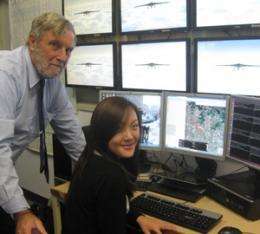Swarming drones could save lives at sea

(Phys.org) -- Inspired by the swarming patterns of animals in nature, a UNSW aerospace engineering PhD student is using biomimicry to improve the marine search and rescue capabilities of unmanned aerial vehicles (UAVs).
Monica Chi, from the School of Mechanical and Manufacturing Engineering at UNSW, is developing computer simulations to test the efficacy of groups of UAVs for finding and tracking people lost at sea.
She has been invited to attend and present her research at the prestigious 2012 International Graduate Summer School in Aeronautics and Astronautics at Beihang University in China this July.
Chi is part of a team of researchers at UNSW using “evolutionary” algorithms to simulate novel and chaotic flight formations for UAVs that mimic the swarm behavior demonstrated by animals such as ants, honeybees, and wolves.
“The strengths of having UAVs rather than piloted vehicles for marine search and rescue is that they are not limited by human capability in terms of flying in dangerous or poor visibility conditions,” says Chi.
“The simulations help us test and analyse new optimising algorithms to reduce the cost and amount of resources consumed in search and rescue, and also to reduce the response time and increase the probability of saving lives,” she says.
In the event of a shipwreck or distress call, one of the first things rescuers do is establish a search boundary. In Chi’s simulations, individual drones in the swarm of UAVs communicate with each other and take cues from their environment through rule sets as they search the specified area.
These rules ensure they deliver maximum search coverage in changing environmental conditions without colliding. When they identify survivors they are programmed to alter their flight patterns so they can track the target in open water until a rescue helicopter or vessel arrives.
Chi says the work is inspired by nature, where swarm behaviour is occurring in many different systems, even in fluids: “Water can be broken down into spherical particles – or individual agents – that follow a set of rules. We decentralise everything and look for the patterns that emerge.”
“There really aren’t many people in the world taking this approach with simulation of UAVs,” says John Page, a senior lecturer in aerospace engineering at UNSW and Chi's supervisor. “In addition to vehicles, we’re also looking at how these swarms can be applied to power generation and other complex systems.”
Provided by University of New South Wales




















